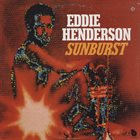 3.94
3.94 |
7 ratings

FunkFreak75
Substitute George Duke for the legend, the master, Herbie Hancock, and young funkmaster Alphonso Johnson for Buster Williams, and Eddie Henderson has pretty much retained the entire Mwandishi lineup for this album. And like most of Jazz-Rock Fusion, the tides have continued to flow, now into the realm of all things funky while retaining the flexibility and virtuosity that is still very much expected if not required of jazz musicians.
1. "Explodition" (6:34) and go! We're off to the races: with one funky, fully-loaded, Young newcomer Alphonso Johnson sure does make an impression right from the start as he essentially-leads this song, setting it's tone, pace, and sound, from the opening note to its close. (9.25/10)
2. "The Kumquat Kids" (4:30) more stanky funk with clavinet and horns filling some of the space on the sides. There must be something in the new Kool-Aid cuz I've never heard normally-straight-and-narrow Eddie Henderson play with such abandon! It's as if he's taken a page from Miles but taken it two steps further. And I'm not even talking about the inundation of multiple special effects poured over multiple instruments in the soundscape. Wow! And I mean, Wow! (9.3333/10)
3. "Sunburst" (5:46) what an opening: drums and high-octave keys support a two-bass funk attack (or perhaps one bass and one bass synthesizer but methinks it really all Alphonso). 90 seconds of this before swayrling synths and cymbal crashings provide a little spacey hesitation and reset. The next passage, built over that opening motif, whirls and spirals around Harvey Mason's drums and Alphonso's bass(es) while Eddie lets loose with some ear-piercing trumpet blasts and riffs before being sucked into the quagmire of the tar pit that is the funky cosmic mess beneath him. Julian Priester's long trombone notes in the spacious whirlpool of the final 90 seconds are quite welcome: something to anchor one's sanity to. It's just that there's so much going on: the precedent set by those expanded lineups established by Miles' Bitches Brew and then perpetuated by Herbie Hancock's Mwandishi lineup lead to so many more layers to each and every song--which is great for re-listens and the creation of thick, lush, full soundscapes like this. (9.5/10)
4. "Involuntary Bliss" (6:49) Alphonso's bass is once again given the job (and honor) of opening up another song-- establishing both pace, mood, and melody. This is simpler, slower, leaving lots of room for George Duke's keys to shine, Harvey Mason's drums to play, and a whole bunch of horn players to let their talents be "seen" and heard. While Eddie takes the first solo, playing some dreamy, long-held and reverberated notes, there are spaces for other musicians to shine: the horns as a section, George Duke on an extended MiniMoog solo, and a little Alphonso Johnson. (13.375/15)
5. "Hop Scotch" (3:52) it's as if the band had the idea of throwing themselves into the making of a big vat of NewOrleans gumbo with this one as there is a lot of funk and N.O. jazz being thrown at us--as if from multiple streams of "flavor" providers--often at the same time! Yeah, give me some of that gumbo! (9/10)
6. "Galaxy" (6:35) long-held spacey synth chords with long trumpet notes opens this for about 75 seconds before bass, drums, keys and the rest of the gang stumble in. The horn sounds being generated by Julian and Bennie are so unusual--though more like swamp insect sounds instead of radiotelescope signals. I love the presence of the marimba in this mix! Bennie Maupin is given the majority of the lead time for his saxello in the middle three minutes well the rest of the crew certainly entertain from beneath. What surprises me even more about this song is how funky it is while Alphonso does not play a funky bass! Instead he's playing an underwater bass that is far less domineering than his usual front-running funkbass. I like this song but it's not developed enough to receive high marks: it's more of a vamp showpiece for everyone to show their weirdest sounds. (8.875/10)
7. "We End in a Dream" (3:10) A long introduction that really shows little or goes nowhere takes a turn at the end of the second minute, establishing a mellow little weave through Alphonso (and Buster?), George, and Billy Hart on drums. And then it just dies. My guess is that Eddie and producer Skip Drinkwater didn't like enough of the new material Eddie's band had conjured up during the allotted paid for studio time so they resurrected something trite but satisfactory from the vaults of previous recording sessions (thus accounting for the presence of both Buster Williams and Billy Hart on this tune only). Not really a complete song, more like a two part idea being explored but never getting past its infancy. (4.375/5)
Total Time 37:16
I have the feeling that the practice and recording sessions for this album were quite limited--especially with respect to new hot-shot "star" Alphonso Johnson's availability--as there are four great funky Jazz-Rock Fusion songs (two of which are credited to Alphonso compositionally) followed by three loose, fun, highly-experimental "knock-around" songs, any one of which might not have made the final public release had there been more songs available "in the can." I can imagine that touring (and recording) with Weather Report would have been pretty demanding
A-/five stars; a minor masterpiece of funked up jazz but also like Alphonso Johnson's breakout album--despite the fact that he'd already participated in the recording of Weather Report's Mysterious Traveller as well as the world tour that followed, as well as the recording sessions of their followup album, Tale Spinnin', which was recorded and released at nearly the same time as Sunburst. Those first five songs are so creative, so alive and entertaining, that I cannot recommend this album more highly.